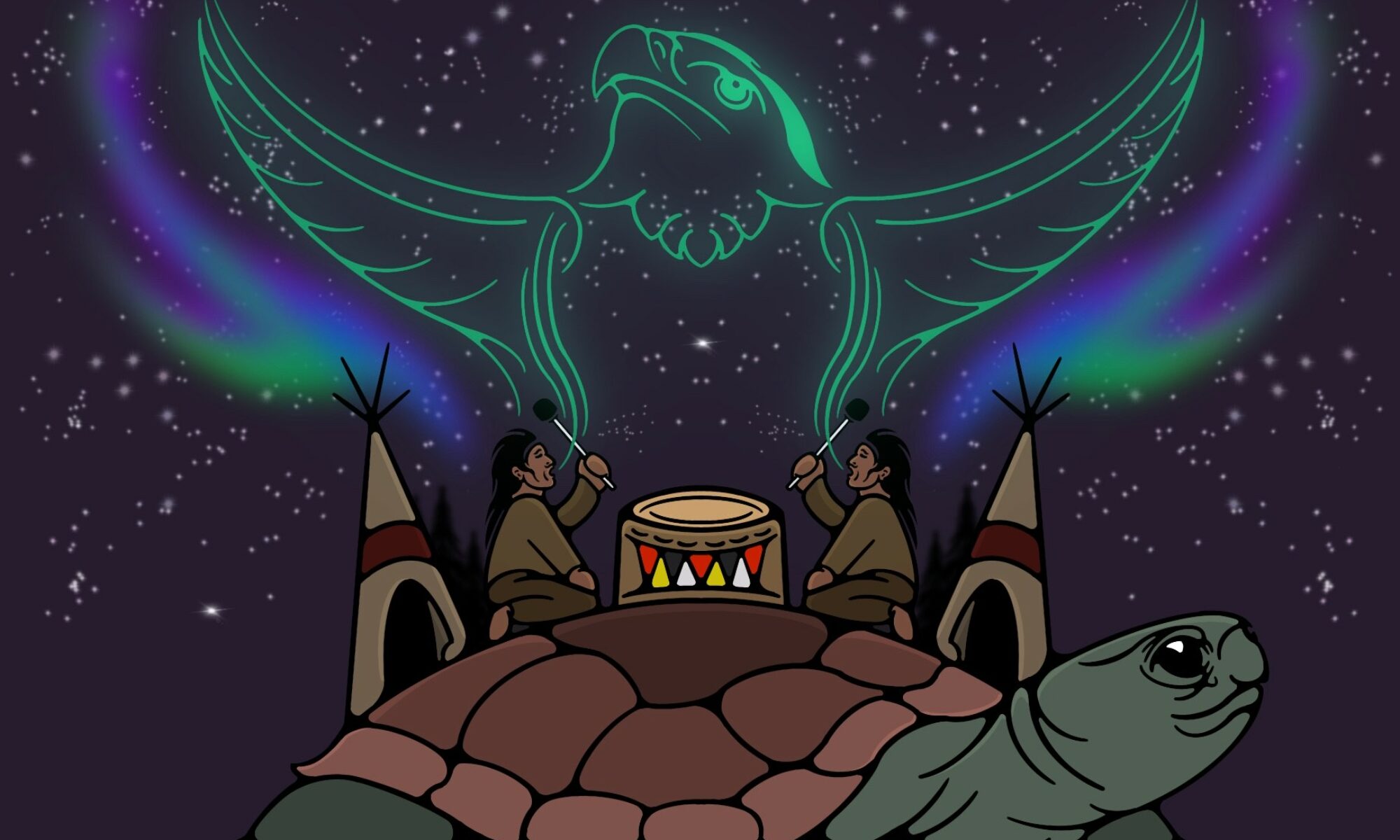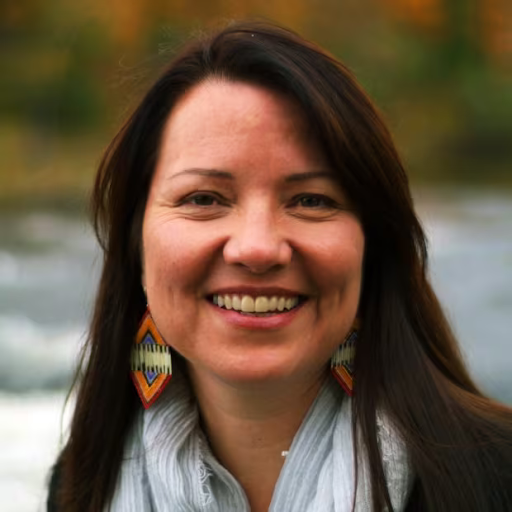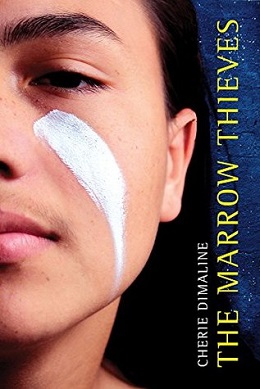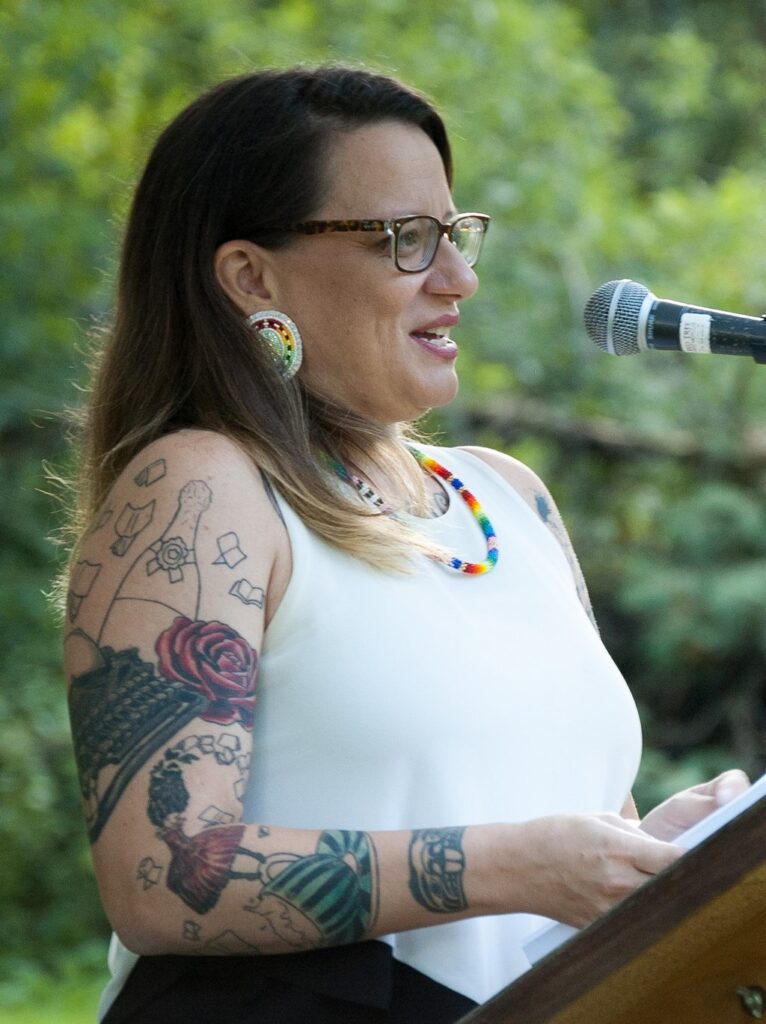Sky Woman’s Great Granddaughters: A Narrative Inquiry Into Kanienkehaka Women’s Identity © Kahente Horn-Miller, 2009.
If you prefer to read this as a PDF, click here
Kahente Horn-Miller is of Akskare:wake (Bear Clan) descent from the Kanien:keha’ka (Mohawk) Indigenous community of Kahnawake, a First Nations reserve located near the city of Montreal, on the banks of the Kaniatarowanenneh (great waterway) known since colonization as the St. Lawrence River. Horn-Miller is an associate professor at Carleton University’s School of Indigenous and Canadian Studies, in Ottawa, Ontario, in the Algonquin Territories, where she is also the first Assistant Vice-president, Indigenous Initiatives. Horn-Miller is a collaborative artist who presented an exhibition entitled “My Mom, Kahntinetha Horn, the ‘Military Mohawk Princess'” at an Ottawa gallery in 2018.
Horn-Miller’s Sky Woman story is a first-person version of a creation story that has many earlier versions, but never in the first person. This tale, part of the oral literature of the Indigenous people of Abya Yala, is the story of the genesis of the Haudenosaunee (Iroquois) people. Horn-Miller says that her version came to her suddenly in an intimate moment with her daughter, and she felt a compelling need to write it down. The Sky Woman Story is also part of her PhD thesis (Concordia University, Montreal, Canada, 2009). When presenting her version of the story, Horn-Miller’s performance is quite striking.
~~~
Sky Woman’s Story
I am the daughter of the Great Spirit. I am Sky Woman. I was born in the Sky World far above the earth at the beginning of time many centuries ago. As a child I was known as Mature Flowers. I was born with the caul covering my face, which made me very special to my people, the Sky Dwellers. I was expected to do great things. My people believed that I had been born by the way of the spirits and not through a physical act. After my birth I was put into protective seclusion by my mother so that I would grow strong and focused. They call this being hidden under the husk, referring to the protective husk surrounding a cob of corn. My uncle, my mother’s brother, was given the duty to advise me and prepare me for adulthood. When he died his body was put at the top of the Great White Pine tree, where he continued to keep a protective watch over me. When I needed his guidance I would call his name three times and climb to the top of the tree and we would talk.
My life in the Sky World was happy. I remember that there was always enough food to eat and no one ever got sick. There was no jealousy or hatred. Every person I knew had special talents and gifts that were nurtured and used for the good existence of everyone. When I and my brothers and sisters were young my mother would carry her babies on her back in a cradle board and hang it in a tree as she and my father worked alongside the men and women of the Sky World cultivating the corn, beans and squash. When I was strong enough, I began to work in the gardens with everyone else. I learned from all the women, and whom I called ‘mother’. I would also help my mothers and sisters in the preparation of the foods. I never wanted for anything. Everything was provided for us to survive. It is said that all the plants and animals that exist on the earth are the same as the ones that exist in the Sky World.
One day, everyone in the Sky World was summoned by The Keeper of the Celestial Tree or Tree of Light by a messenger who came to the people. When the people went to see him, they were told that a dream needed to be deciphered before the flowers on the tree stopped blooming forever. If this were to happen, there would be darkness that would disrupt creation in the Sky World. After this event great calamity and hardship would come and things would change forever. The meaning of the dream, it was told, would have an effect on everyone in the Sky World. Many people tried to interpret the dream but failed. The Keeper tossed them into a hole near his tree that led to the world below where they were transformed into new beings. My mother went to the council but didn’t bring me as I had asked. As a young adult, I was too distraught at having to be involved in such a great responsibility as dream interpretation. I wanted so desperately to be a child for much longer. I went instead to see Uncle at the top of the Great White Pine.
I walked through the forest, watching the light and shadows through the trees as I thought about the dream and the council. When I arrived, I slowly climbed the Great White Pine. To reach the top took all my strength. I pulled myself up onto one of the topmost branches and I saw Uncle lying there.
“Uncle,” I asked. “What should I do? A very important meeting has been called. The Keeper has asked the People to help him interpret an important dream. I don’t want to be burdened by such seriousness. I am just a child.”
“It is almost time for you to fulfill your destiny,” he told me. “You are almost old enough, you are almost strong enough and you are certainly wise beyond your years. Soon, you will be asked to go to the Keeper of the Tree of Light. When you go, tell him who you are and that you have come to help him. Tell him you have the power to bring new life to the blossoms that light up the Sky World.”
Uncle instructed me that the Keeper and I would look over the things that had been thrown out of the Sky World and were coming to life in the world below. Uncle cautioned me closely.
“Do not sleep on any mat he offers you.”
I looked at Uncle with questioning eyes, but I nodded my head in agreement. Little did I know that once the creative process began, things would change in the Sky World and the world below—Light would dim in the Sky World as light grew below. Only when light began to dim below, then the light would renew itself in the Sky World, which I couldn’t understand. Uncle told me of many other things that would occur when I went to see The Keeper. I listened closely because I trusted and loved Uncle.
This story I am telling you is one that comes from my long memory, the memories of my children, and the collective memories of my many great granddaughters. I can look back on my life and see it with such clarity, as if it happened yesterday. The memories are vivid and still very much alive, kept in the minds and hearts of my descendants. Through them, I pass on my knowledge.
As I climbed down the Great White Pine and walked away back to my lodge, I felt calm for the first time. Shortly after I arrived home, Mother came back from the council.
“We were not able to help The Keeper,” she told me. “So those of us who were left, we talked amongst ourselves. Daughter, we all know you are meant to do something special. People of the Sky World have counseled and we agree that when you are old enough, you are to go to The Keeper of the Tree of Light to help him interpret his dream so that balance and light will remain in the Sky World.”
I looked at her with wondering eyes but I didn’t question her. Uncle had prepared me for this.
When I was old enough a messenger came from The Keeper, a feast was to be given and I was invited. I went to see the Keeper of the Tree of Light as instructed.
“Who are you?” he asked. “What are you doing? Why are you doing that?”
“I am the girl they call Mature Flowers. I have come to help you as Uncle instructed me.”
I continued.
“I heard you were giving a feast.”
The Keeper seemed to know me as though he had been expecting me. I was surprised when he told me that I was the reason for the feast. He looked at me and smiled.
“You were born with a great gift. You are the Sky World’s only hope of keeping the Tree of Light lit.”
As he said these words, he pointed to the blossoms on the Tree of Light. I looked at them closely, cradling one in my palm. I saw that their beauty and light was dimming. The Tree was beginning to die. I felt saddened by their dimming beauty. I had tears in my eyes.
“How is it that I can help you?”
The Keeper told me to prepare for the feast some mush made from chestnuts that we would eat together. As I was cooking the mush it sputtered and stuck to my body, burning me. I didn’t cry out but whimpered under my breath in pain. My breath came in small short gasps as the white hot searing pain of the burning mush brought tears to my eyes. I held back my tears and continued to push the air through my teeth as I worked to prepare the mush. When it was finished I called out that the mush was ready. When The Keeper saw me, he was shocked to see my burned body.
“The mush sputtered and burned me. I am in pain.”
The Keeper immediately called out two white dogs that came forward and licked the mush from my body. As the dogs’ tongues cleansed my body I remained motionless and didn’t wince. With the dogs’ saliva coating my burned flesh, I began to feel less pain and my skin began to heal quickly. Their work brought me peace.
When I was well enough, I brought the mush into The Keeper’s lodge and we sat to eat. We ate. As we ate, The Keeper spoke:
“Many people are on their way to play a game called The Little Brother of War.”
“The game will divert my mind from the problems at hand. I will ask that you not speak to anyone who comes to play or to watch the game. If you do this then you can stay.”
I agreed to his request. We finished our food and walked to a clearing a short distance away. As we walked I could hear the voices of the men calling to each other over the field. As the game went on, many of my people came up to speak to me but I remained silent as requested. It was hard for me to do.
After a while, The Keeper asked me to go to the stream and get him some water. I found the stream and crouched at the shore as I filled a wooden bowl. I stood up and as I turned a player came up to me and asked me for a drink. Naturally, I replied that he could have some. Suddenly a cold feeling came over me. I realized that I had broken The Keeper’s request that I not speak to anyone. I refilled the bowl and headed back to The Keeper. He was angry with me for disobeying his request and he sent me back to my mother with instructions.
For more about Kahente Horn-Miller
- Continue reading this story in Kahente’s Doctorate thesis.
- An Interview in Working It Out Together.
- “You may have stolen and mined our lands, but you will not steal and mine our names”, an opinion piece in CBC, 2018.
Sky Woman’s Great Granddaughters: A Narrative Inquiry Into Kanienkehaka Women’s Identity
© Kahente Horn-Miller, 2009 ~ Siwar Mayu, November 2023



